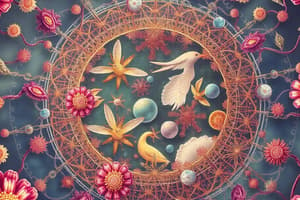Podcast
Questions and Answers
What is the primary function of mitochondria?
What is the primary function of mitochondria?
- Facilitate protein synthesis
- Generate energy through photosynthesis
- Convert oxygen and nutrients into ATP (correct)
- Produce phospholipids for membrane formation
What is the structure of the inner membrane of mitochondria?
What is the structure of the inner membrane of mitochondria?
- Smooth and continuous
- Completely impermeable
- Highly folded, forming cristae (correct)
- Contains chlorophyll for photosynthesis
What sets mitochondria apart from most other organelles?
What sets mitochondria apart from most other organelles?
- Possession of its own circular DNA (correct)
- Dependence on the cell for reproduction
- Lack of a membrane structure
- Ability to perform photosynthesis
True or false: The Golgi apparatus is particularly abundant in cells that secrete proteins.
True or false: The Golgi apparatus is particularly abundant in cells that secrete proteins.
True or false: Vacuoles help plants maintain their shape by containing a water solution.
True or false: Vacuoles help plants maintain their shape by containing a water solution.
True or false: The smooth endoplasmic reticulum lacks ribosomes and is involved in synthesizing lipids and detoxifying drugs and poisons?
True or false: The smooth endoplasmic reticulum lacks ribosomes and is involved in synthesizing lipids and detoxifying drugs and poisons?
Where does ribosome assembly begin?
Where does ribosome assembly begin?
What is the primary function of bound ribosomes?
What is the primary function of bound ribosomes?
What is the function of the Golgi apparatus?
What is the function of the Golgi apparatus?
True or false: Both plant and animal cells contain centrioles.
True or false: Both plant and animal cells contain centrioles.
True or false: The primary function of the nucleus is to produce ATP for the cell.
True or false: The primary function of the nucleus is to produce ATP for the cell.
Flashcards are hidden until you start studying
Study Notes
- The nuclear membrane is a selectively permeable membrane that maintains the shape of the nucleus and allows large macromolecules to pass through.
- The nucleus contains chromatin fibers, which are made up of DNA and proteins. When the cell prepares to divide, these fibers condense and become visible as chromosomes. Each eukaryotic species has a characteristic number of chromosomes.
- The nucleus directs protein synthesis by producing messenger RNA (mRNA), which travels to the cytoplasm and combines with ribosomes to create proteins. Ribosomes are made up of ribosomal RNA (rRNA) and proteins.
- The nucleolus is a dark region within the nucleus that is involved in the production of ribosomes.
- Ribosomes are RNA-protein complexes that synthesize proteins. They are made up of two subunits (large and small) that join and attach to mRNA.
- The endoplasmic reticulum (ER) is a large membrane system that plays a role in protein synthesis and lipid synthesis, as well as a storage and secretion system. It is composed of a lipid bilayer and serves as a network of channels from the nucleus.
- The Golgi apparatus is a collection of Golgi bodies that are responsible for modifying, packaging, and shipping materials to other parts of the cell. It is particularly abundant in secretory cells and is involved in the synthesis of pectin and polysaccharides.
- Lysosomes are membrane-bound compartments that contain digestive enzymes and serve to break down and recycle macromolecules. They are synthesized in the ER and are transferred to the Golgi apparatus before being taken to the lysosomes.
- Vacuoles are membrane-bound sacs that have a variety of functions, including storage, digestion, and waste removal. They contain a water solution and help plants maintain their shape.
- Peroxisomes are membrane-bound organelles that contain enzymes for degrading amino acids and fatty acids. They also detoxify harmful compounds and produce hydrogen peroxide as a byproduct of cellular metabolism. Peroxisomes exist extensively in liver cells and have the ability to convert hydrogen peroxide to water.
- The ER has two types: smooth (lacks ribosomes) and rough (has ribosomes attached to the outside). Smooth ER is rich in enzymes and plays a role in lipid synthesis, while rough ER is especially abundant in cells that secrete proteins.
- The Golgi apparatus is made up of Golgi bodies, which collect, package, and distribute molecules synthesized at one location in the cell and utilized at another location.
- Lysosomal enzymes hydrolyze proteins, fats, polysaccharides, and nucleic acids, and they help white blood cells destroy bacteria.
- Vacuoles come in different types, including food vacuoles, contractile vacuoles, and central vacuoles. Food vacuoles fuse with lysosomes for digestion, contractile vacuoles help maintain water balance, and central vacuoles store waste and maintain turgidity.
- Peroxisomes contain enzymes for degrading amino acids and fatty acids, and they detoxify alcohol and other harmful compounds. The reactions in peroxisomes produce hydrogen peroxide as a byproduct, but they also have enzymes that convert hydrogen peroxide to water.
- Peroxisomes break down fatty acids into smaller molecules that are transported to mitochondria for fuel.
- Peroxisomes are self-replicating, unlike lysosomes, which are formed in the Golgi complex.
Studying That Suits You
Use AI to generate personalized quizzes and flashcards to suit your learning preferences.




